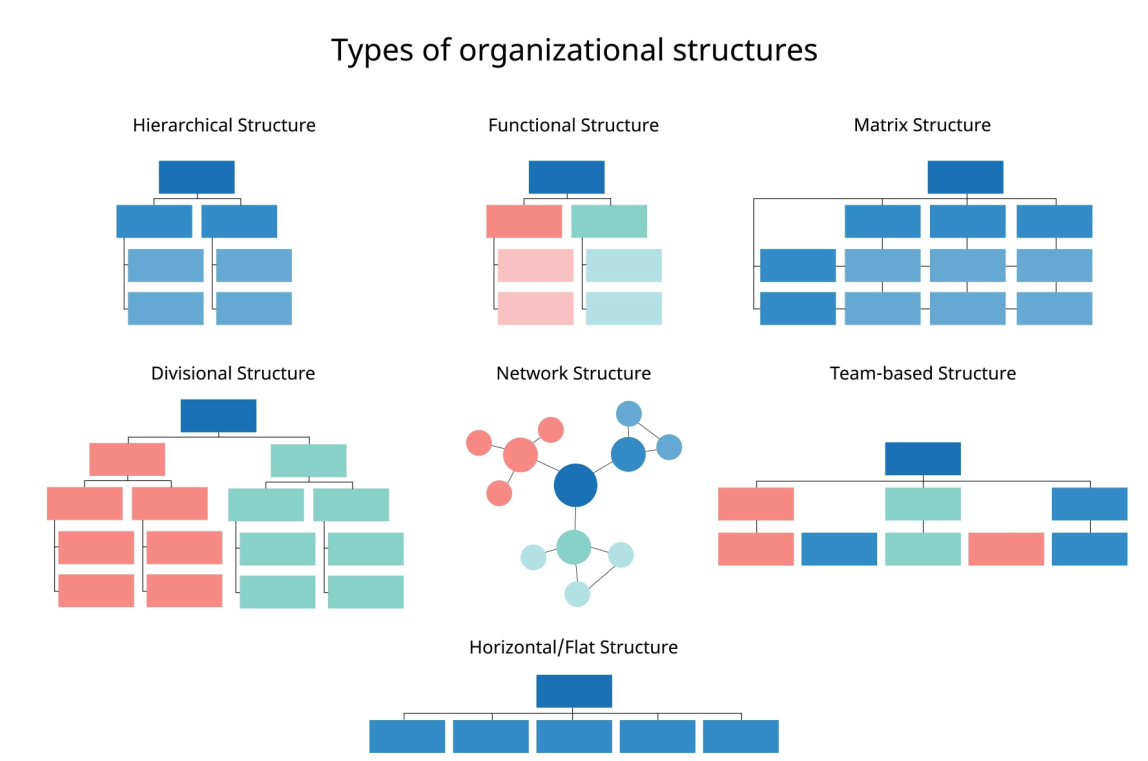In the ever-shifting landscape of contemporary business, the interplay between organizational structure and development stands as the linchpin for sustained success. As enterprises grapple with dynamic market forces, understanding the intricacies of various organizational structures and their implications becomes paramount.
This article embarks on a comprehensive exploration, traversing through hierarchical arrangements, flat hierarchies, matrix structures, functional hierarchies, divisional structures, network configurations, and the dichotomy of centralization versus decentralization. Beyond these structural nuances, we delve into the stages of organizational development, examining the challenges and solutions encountered at each step. Real-life examples of companies that have navigated restructuring illuminate the strategies, challenges, and ultimate gains. As we navigate this journey, we also scrutinize the profound impact of the COVID-19 pandemic on organizational structure and development, paving the way for a thoughtful and forward-looking conclusion.
Section 1: Understanding Organizational Structure
1.1 Definition and Importance
Organizational structure is the framework defining how tasks, roles, and responsibilities are allocated and coordinated within an organization. A well-crafted structure enhances operational efficiency, communication, and decision-making.
1.2 Types of Organizational Structures
1.2.1 Hierarchical Structure
Hierarchical structures have a clear chain of command with distinct levels of management. This traditional model provides stability but may hinder agility.
Pros:
- Clear Hierarchy: Simplifies decision-making.
- Defined Roles: Reduces ambiguity.
Cons:
- Rigidity: May impede adaptability.
- Communication Hurdles: Can slow down communication.
Example: The military often employs a hierarchical structure for clear command and control.
1.2.2 Flat Hierarchy
Flat hierarchies minimize management layers, fostering quicker decision-making and open communication.
Pros:
- Flexibility: Adapts well to change.
- Enhanced Communication: Encourages open dialogue.
Cons:
- Potential Chaos: May lead to role confusion.
- Managerial Challenges: Managing larger teams can be daunting.
Example: Valve Corporation’s flat structure encourages employee autonomy and innovation.
1.2.3 Functional Hierarchy
Functional structures group employees based on specialized skills or functions, promoting expertise.
Pros:
- Expertise Development: Fosters specialized skills.
- Efficient Supervision: Clear reporting lines.
Cons:
- Limited Cross-Functional Communication: May hinder collaboration.
- Slow Decision-Making: Decision-making can be slow due to hierarchy.
Example: Ford’s functional structure organizes teams by specific functions.
1.2.4 Divisional Structure
Divisional structures organize the company into self-contained units, often based on geographic regions or product lines.
Pros:
- Market Focus: Tailors strategies to specific markets.
- Autonomy: Divisions operate semi-independently.
Cons:
- Duplication of Efforts: May lead to inefficiencies.
- Communication Challenges: Inter-division communication can be difficult.
Example: General Electric’s divisions include aviation, healthcare, and energy.
1.2.5 Centralization versus Decentralization
Centralization: Centralization involves concentrating decision-making authority at the top of the hierarchy. This structure provides clear control but may hinder innovation and adaptability.
Decentralization: Decentralization disperses decision-making authority across various levels. It encourages autonomy but may lead to coordination challenges.
Example: Amazon, in its early days, had a highly centralized structure under Jeff Bezos, facilitating swift decision-making.
1.2.6 Team-Based Structures
Team-based structures focus on organizing employees into self-directed teams, fostering collaboration and shared responsibilities.
Pros:
- Collaboration: Promotes teamwork and shared goals.
- Adaptability: Teams can quickly respond to changes.
Cons:
- Conflict Resolution: Managing conflicts within teams may be challenging.
- Dependency: Success relies heavily on effective team dynamics.
Example: Zappos, an online shoe and clothing retailer, adopted a team-based structure to encourage employee collaboration and creativity.
1.2.7 Composite Structure
Composite structures combine elements of different organizational structures, allowing for flexibility and customization.
Pros:
- Adaptability: Can adapt to various organizational needs.
- Optimized Efficiency: Allows for specialization in different areas.
Cons:
- Complexity: Managing multiple structural elements can be complex.
- Clarity Challenges: Employees may face challenges understanding the hybrid structure.
Example: Large consulting firms often adopt composite structures to cater to different client needs, combining functional and divisional elements.
Different types of composite structures:
Composite organization structures combine elements from different traditional organizational structures to create a hybrid model that suits the specific needs and goals of a company. These structures often emerge as a response to the complexities and challenges posed by dynamic business environments. Below are explanations of some common types of composite organization structures, along with real-life company examples:
- Matrix Organization Structure:
- Description: Combines functional and project-based structures, establishing dual reporting relationships to enhance flexibility and resource utilization.
- Pros:
- Enhanced flexibility and resource utilization.
- Efficient expertise utilization with dual reporting relationships.
- Quick decision-making due to direct project-related authority.
- Cons:
- Power struggles and potential conflicts.
- Complex communication between functional and project managers.
- Role ambiguity for employees.
- Example: Boeing employs a matrix structure, allowing employees to report to both functional and project managers, streamlining the management of complex aerospace projects.
- Network Organization Structure:
- Description: Delegates functions to external partners, emphasizing collaboration and specialization to adapt quickly to changes.
- Pros:
- Specialized expertise from external partners.
- Flexibility to adapt quickly to changes.
- Cost-effective through outsourcing and partnerships.
- Cons:
- Dependency on external partners.
- Coordination challenges across a network.
- Risk of information leakage.
- Example: Apple relies on a network structure, collaborating with a global network of suppliers and manufacturers for its product development and manufacturing.
- Boundaryless Organization Structure:
- Description: Breaks down traditional organizational barriers, fostering innovation and cross-functional collaboration for adaptability.
- Pros:
- Encourages innovation by breaking down traditional barriers.
- Facilitates cross-functional collaboration and knowledge sharing.
- Enhances adaptability to changes in the external environment.
- Cons:
- Employee resistance to breaking down traditional structures.
- Coordination challenges across functions.
- Difficulty achieving a common organizational culture.
- Example: General Electric (GE) has embraced a boundaryless structure to foster innovation and collaboration across its diverse business units.
- Hollow or Virtual Organization Structure:
- Description: Focuses on core competencies while outsourcing non-core functions, aiming for cost efficiency and flexibility.
- Pros:
- Focus on core competencies.
- Cost efficiency through outsourcing.
- Flexibility to adapt to changing market conditions.
- Cons:
- Loss of control over outsourced functions.
- Communication challenges with external partners.
- Dependence on external suppliers.
- Example: Nike follows a virtual organizational structure, concentrating on design and marketing while outsourcing manufacturing to various global suppliers.
- Projectized Organization Structure:
- Description: Entire organization is project-oriented, ensuring a clear focus on project goals, efficient resource allocation, and defined project team roles.
- Pros:
- Clear focus on project goals and objectives.
- Efficient resource allocation dedicated to projects.
- Clearly defined roles and responsibilities for project teams.
- Cons:
- Limited access to functional expertise.
- Resource constraints if functional departments are not adequately involved.
- Intense competition for resources between projects.
- Example: AECOM, a multinational engineering firm, structures its teams around specific projects, optimizing resources for various engineering and construction endeavors.
- Matrix with Integrated Project Teams (IPT):
- Description: Integrates elements of matrix and projectized structures, emphasizing collaboration and shared resources between functional and project teams.
- Pros:
- Collaboration between functional and project teams.
- Efficient resource utilization and sharing across projects.
- Integration of specialized expertise into project teams.
- Cons:
- Complexity in managing the matrix with IPT.
- Potential conflicts between functional and project managers.
- Challenges in defining decision-making authority.
- Example: Lockheed Martin utilizes a matrix with IPT, organizing teams around specific projects, encouraging close collaboration between functional and project teams.
- Flexible Organization Structure:
- Description: Fosters an environment encouraging innovation and collaboration, allowing for adaptability and cross-functional knowledge sharing.
- Pros:
- Fosters an environment encouraging innovation and creativity.
- Enhances adaptability to changes in the business landscape.
- Promotes cross-functional collaboration and knowledge sharing.
- Cons:
- Lack of structure leading to role ambiguity.
- Coordination challenges across flexible teams.
- Potential for chaos and a lack of organizational control.
- Example: Google adopts a flexible organizational structure, promoting innovation and collaboration across various functions to stay agile in the dynamic tech industry.
It’s important to note that companies often tailor their organizational structures based on their unique industry, size, and strategic goals. Hybrid or composite structures allow organizations to balance conflicting demands and capitalize on diverse strengths, promoting agility in today’s dynamic business environment.
1.2.11 Holacracy and Adhocracy
Holacracy: Holacracy is a decentralized management system that distributes authority across self-organizing teams, fostering autonomy and agility.
Pros:
- Flexibility: Allows for rapid decision-making.
- Employee Empowerment: Empowers employees to make decisions.
Cons:
- Clarity Challenges: Requires a mindset shift and clear communication.
- Potential Chaos: Lack of strict hierarchy may lead to ambiguity.
Example: Zalando, a European e-commerce company, adopted holacracy to encourage innovation and adaptability.
Adhocracy: Adhocracy emphasizes flexibility, innovation, and creativity, allowing organizations to adapt quickly to changing environments.
Pros:
- Innovation: Encourages creative problem-solving.
- Adaptability: Can quickly respond to market changes.
Cons:
- Lack of Structure: May lead to chaos without clear guidelines.
- Risk of Failure: Innovative approaches may not always succeed.
Example: Google’s experimental projects, like Google X, operate within an adhocratic framework to encourage innovation.
Section 2: The Evolution of Organizational Development
2.1 The Concept of Organizational Development
Organizational development involves planned efforts to enhance an organization’s effectiveness, performance, and employee well-being. It includes stages like diagnosis, planning, intervention, and evaluation.
2.2 Stages of Organizational Development
2.2.1 Diagnosis
In the diagnosis stage, organizations assess their current state, identifying strengths, weaknesses, opportunities, and threats.
HR Challenges:
- Resistance to Assessment: Employees may resist the evaluation process.
- Data Accuracy: Ensuring accurate data for analysis can be challenging.
Example: General Electric’s diagnostic stage involved comprehensive analysis of its diversified business units.
2.2.2 Planning
Planning involves formulating strategies and action plans based on the diagnosis.
HR Challenges:
- Resistance to Change: Employees may resist proposed changes.
- Alignment of Goals: Ensuring all departments align with the organizational goals.
Example: IBM’s planning phase included strategies to realign its business units for improved efficiency.
2.2.3 Intervention
Intervention involves implementing planned changes, whether structural, cultural, or procedural.
HR Challenges:
- Employee Morale: Managing employee morale during changes.
- Communication Overload: Ensuring effective communication of changes.
Example: Microsoft’s cultural intervention involved a shift toward a growth mindset, fostering innovation.
2.2.4 Evaluation
Evaluation assesses the impact of interventions, measuring effectiveness and making adjustments.
HR Challenges:
- Resistance to Evaluation: Employees may resist ongoing assessments.
- Data Analysis: Ensuring accurate analysis of intervention impact.
Example: Google continuously evaluates its workplace practices, iterating on its famous “20% time” policy.
Section 3: Integrating Structure and Development for Success
Organizational success is contingent upon the intricate interplay between its structural framework and developmental strategies. Achieving a seamless integration of these elements is paramount in navigating the multifaceted challenges of today’s dynamic business environment. In this section, we delve deeper into the complex relationship between organizational structure and development, emphasizing the symbiotic nature that underpins sustainable success.
3.1 The Interplay Between Structure and Development
The dynamic relationship between organizational structure and development is a linchpin in the effective functioning of any prosperous enterprise. The chosen organizational structure significantly influences the organization’s capacity for development, and conversely, the success of development initiatives often necessitates structural adjustments. This interplay highlights the fluidity of organizational growth, stressing the importance of aligning structural choices with evolving developmental strategies.
For example, consider a traditional hierarchical structure; while it might enhance efficiency in a stable environment, it could stifle innovation due to rigid reporting structures. Conversely, a more flexible, team-based structure may foster creativity but might face challenges in maintaining centralized control. Striking the right balance involves a nuanced understanding of how structural changes can either facilitate or impede the implementation of development initiatives.
3.2 Agile Organizations: A Modern Approach
In the contemporary business landscape, the concept of agility has emerged as a guiding principle for organizational success. Agile structures prioritize adaptability, collaboration, and iterative development. Recognizing the symbiotic relationship between structure and development, successful organizations are increasingly adopting agile methodologies to enhance their ability to respond to dynamic market conditions and capitalize on emerging opportunities.
3.2 Agile Organizations: A Modern Approach
Agile structures prioritize adaptability, collaboration, and iterative development.
Successful organizations understand that structural decisions impact development initiatives and vice versa. The adaptability of the structure to change and innovation is crucial for long-term success. Agile organizations recognize the need for fluidity, allowing them to pivot swiftly in response to market shifts and internal evolution.
Example: Spotify’s Agile Model
Spotify’s agile structure empowers small, cross-functional teams, fostering innovation and responsiveness in the dynamic tech industry.
Spotify is renowned for its unique approach to implementing Agile principles, often referred to as the “Spotify Model” or “Spotify Agile Model.” This model is designed to foster innovation, collaboration, and flexibility within large organizations. Here are key components of Spotify’s Agile model:
- Squads:
- Squads are cross-functional, self-organizing teams that focus on specific features or components.
- Each squad is responsible for end-to-end delivery, including development, testing, and deployment.
- Squad members may include developers, testers, designers, and other roles necessary for the team’s autonomy.
- Tribes:
- Squads are grouped into Tribes based on shared business objectives or functions.
- Tribes bring together multiple squads working toward a common goal.
- Each Tribe has a Tribe Lead responsible for coordinating efforts and ensuring alignment with overall business objectives.
- Chapters:
- Chapters consist of individuals with similar skills or expertise across different squads.
- For example, all front-end developers may belong to the same chapter, irrespective of their squad.
- Chapters provide a platform for knowledge sharing, skill development, and maintaining consistency in practices.
- Guilds:
- Guilds are cross-cutting groups that focus on a specific aspect of work, such as a technology or practice.
- Members of guilds come from different squads and chapters, encouraging knowledge exchange and best practice sharing.
- Guilds are more informal and voluntary compared to chapters.
- Tribe Leads:
- Tribe Leads are responsible for overseeing the work of multiple squads within a tribe.
- They play a crucial role in aligning squad efforts with the overall business strategy and goals.
- Tribe Leads facilitate collaboration and communication across squads.
- Spotify Engineering Culture:
- Spotify places a strong emphasis on its engineering culture, fostering a mindset of autonomy, mastery, and purpose.
- The culture encourages innovation, experimentation, and learning from failures.
- Teams are empowered to make decisions independently, promoting a sense of ownership and responsibility.
- Agile Rituals:
- Spotify follows Agile ceremonies such as sprint planning, retrospectives, and daily stand-ups.
- Continuous integration and delivery (CI/CD) practices are fundamental, enabling frequent releases and quick response to feedback.
- Mission, Vision, and Strategy:
- Spotify aligns its squads and tribes with a clear mission, vision, and strategy.
- This alignment ensures that teams are working towards common goals and objectives.
It’s important to note that while the Spotify Model has gained popularity, it may not be suitable for every organization. Different companies may need to adapt and tailor Agile frameworks based on their unique needs and context.
Other examples:
While many companies adopt Agile principles, the specific organizational structures can vary based on their unique needs, industry, and culture. Here are brief explanations of Agile organizational structures from a few notable companies:
- Scrum at Scale – Scrum.org:
- Scrum at Scale, developed by Jeff Sutherland (one of the co-creators of Scrum), is designed to scale Scrum principles beyond individual teams.
- It introduces the concept of a “Scaled Scrum Master” and a “Scaled Product Owner” to coordinate and align multiple Scrum teams.
- The framework provides guidance on how to coordinate work, synchronize events, and manage dependencies across multiple Scrum teams.
- SAFe (Scaled Agile Framework) – Scaled Agile, Inc.:
- SAFe is one of the most widely adopted Agile frameworks for large enterprises.
- It organizes teams into Agile Release Trains (ARTs), which are groups of Agile teams aligned to a common mission.
- The framework includes roles such as Release Train Engineer (RTE), Product Owner, and System Architect, which help coordinate and align work at the program and portfolio levels.
- LeSS (Large-Scale Scrum) – LeSS Company:
- LeSS is an Agile scaling framework that extends the principles of Scrum to large organizations.
- It focuses on simplifying the organizational structure by maintaining as much of the simplicity of Scrum as possible.
- LeSS encourages the formation of feature teams that are cross-functional and self-managing, avoiding unnecessary layers of hierarchy.
- Holacracy – Zappos:
- Zappos, an online shoe and clothing retailer, adopted a radical approach to organizational structure known as Holacracy.
- Holacracy replaces traditional hierarchical structures with a system of self-governance, where teams, or “circles,” have the authority to make decisions within their domains.
- Roles and responsibilities are distributed across circles, and decision-making is more decentralized.
- Agile Transformation – ING Bank:
- ING Bank, during its Agile transformation, adopted a model known as the “Agile Way of Working.”
- It involves the creation of “squads” and “tribes,” similar to the Spotify model.
- Squads are small cross-functional teams, and tribes are groups of squads aligned by a common business goal.
- Agile Coach Approach – Airbnb:
- Airbnb has adopted an Agile coaching approach to instill Agile principles and practices across the organization.
- The company has Agile coaches who work with teams to facilitate the adoption of Agile methodologies.
- The focus is on continuous improvement and creating an environment that encourages collaboration and innovation.
It’s crucial to recognize that each company’s Agile organizational structure is shaped by its unique context, goals, and challenges. Organizations may adopt or adapt frameworks based on what best suits their needs and helps them achieve agility in their specific industry and market conditions. Agile practices are often tailored to fit the organizational culture and context, emphasizing flexibility and continuous improvement.
Steps in forming an agile organization:
In the contemporary business landscape, the concept of agility has emerged as a guiding principle for organizational success. Agile structures prioritize adaptability, collaboration, and iterative development. Recognizing the symbiotic relationship between structure and development, successful organizations are increasingly adopting agile methodologies to enhance their ability to respond to dynamic market conditions and capitalize on emerging opportunities.
Examples:
- Scrum Framework: Within agile organizations, the Scrum framework is widely adopted. It involves cross-functional teams working collaboratively in short, time-boxed iterations (sprints). This approach fosters continuous improvement and rapid adaptation to changing requirements.
- Kanban Methodology: Another example is the Kanban methodology, which emphasizes visualizing workflow and optimizing the flow of work. It allows teams to manage and prioritize tasks in a way that is responsive to changing demands.
Steps in Agile Organization Formation:
- Assessment of Current State: Understand the existing organizational structure, its strengths, and weaknesses. Identify areas that need improvement and determine the level of agility required.
- Leadership Alignment: Gain commitment from leadership to embrace an agile mindset. This involves aligning leaders with the principles of adaptability, collaboration, and iterative development.
- Cross-Functional Teaming: Form cross-functional teams that bring together diverse skills and perspectives. This fosters collaboration and enhances the organization’s ability to respond to complex challenges.
- Training and Skill Development: Provide training to employees on agile methodologies and encourage skill development. This ensures that the workforce is equipped to operate within the agile framework.
- Implement Agile Practices: Gradually introduce agile practices such as daily stand-up meetings, sprint planning, and retrospectives. This step-by-step implementation helps the organization adapt to the new way of working.
- Continuous Improvement: Foster a culture of continuous improvement, where teams regularly reflect on their processes and identify opportunities for enhancement. This iterative approach is at the core of agile organizations.
Section 4: Challenges and Solutions
4.1 Common Challenges in Organizational Structure and Development
Navigating the terrain of organizational structure and development is not without its challenges. Recognizing and addressing these challenges is pivotal for sustained success.
4.1.1 Centralization Challenges
HR Practices:
- Top-Down Communication: Centralized structures often rely on top-down communication.
- Streamlined Policies: Policies are centralized for consistency.
Challenges:
- Innovation Hurdles: Innovation may be stifled due to limited input from lower levels.
- Slow Responsiveness: Decision-making may be slow, hindering responsiveness.
Example: General Motors faced challenges in innovation due to a highly centralized structure.
4.1.2 Decentralization Challenges
HR Practices:
- Empowerment Programs: Decentralized structures often emphasize empowerment.
- Adaptive Policies: Policies may be adapted to suit local contexts.
Challenges:
- Coordination Issues: Decentralization may lead to coordination challenges.
- Inconsistent Policies: Inconsistencies may arise in policy implementation.
Example: 3M embraced decentralization, but coordination challenges arose, prompting a balance between central control and autonomy.
4.2 Real-Life Example: IBM’s Restructuring Journey
Real-life examples of organizational restructuring provide insights into the challenges and benefits of such initiatives. IBM, a stalwart in the tech industry, underwent a significant restructuring journey to realign its business units and streamline operations. The rationale behind the restructuring was to enhance efficiency, reduce duplication, and respond more effectively to market demands.
Steps Taken:
- Portfolio Assessment: IBM conducted a thorough assessment of its business portfolio, identifying areas of strength and redundancy.
- Business Unit Realignment: The company realigned its business units to better reflect market demands and technological trends.
- Workforce Optimization: Workforce restructuring was a key component, with a focus on retaining key talent while optimizing overall workforce size.
Challenges Faced:
- Employee Morale: Workforce restructuring led to concerns about job security and potential layoffs, impacting employee morale.
- Implementation Complexity: Implementing changes across a global organization presented logistical and operational complexities.
Net Gain: While challenges were evident, the restructuring led to a more streamlined and agile IBM. The company reported improved financial performance, increased innovation, and a more responsive approach to client needs.
Section 5: The Future of Organizational Structure and Development
5.1 Emerging Trends
As we peer into the future, several trends are reshaping the landscape of organizational structure and development.
5.1.1 HR Practices in Remote Work
HR Practices:
- Digital Collaboration Tools: Adoption of tools for remote collaboration.
- Employee Well-being Programs: Focus on programs supporting remote employees.
Challenges:
- Work-Life Balance: Striking a balance between work and personal life.
- Team Cohesion: Maintaining team cohesion in a virtual environment.
Example: Twitter’s announcement of permanent remote work reflects a trend in embracing remote-friendly HR practices.
Section 6: The Impact of COVID-19 on OSD
The COVID-19 pandemic has acted as a catalyst for change, significantly impacting organizational structure and development.
Remote Work: Companies like Twitter and Facebook announced permanent remote work options, signaling a potential shift in traditional structures.
Digital Transformation: The pandemic prompted a rapid adoption of digital technologies, influencing how organizations approach OSD in a digitally driven world.
Employee Well-being: There is an increased focus on employee well-being, considering the challenges posed by remote work and the blurred lines between personal and professional life.
Conclusion
In the intricate dance between organizational structure and development, successful leaders navigate the complexities of modern business with a keen understanding of structure nuances, development stages, and the challenges therein. Real-world examples, such as IBM’s restructuring journey, illuminate the importance of adaptability and strategic decision-making. As we stand at the intersection of tradition and innovation, centralization and decentralization, the ability to harmonize structure with dynamic development strategies remains paramount for organizational resilience and prosperity.
As you reflect on the exploration of OSD, ponder: How can your organization leverage its structure for effective development? What changes in OSD could enhance employee engagement and innovation? The future beckons with challenges and opportunities; how will your organization navigate the evolving landscape of business? In the realm of centralization and decentralization, what structure aligns with your organization’s vision? Thoughtful consideration and strategic decisions will undoubtedly pave the way for organizational success in the years to come.











